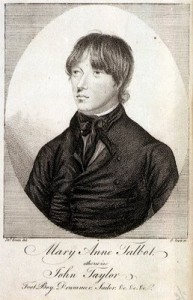The material in the archives at the Greater Manchester County Record Office continues to surprise me. When I started researching the history of women dressing as men, I had no idea that the archives would contain such a vast and diverse array of sources, including the article below, which describes a Manchester lady who may have served as a soldier in the late 1700s:
Image may be NSFW.
Clik here to view.
Above: A Full Account of the Life of Sarah Roberts, the Female Soldier (source)
There is no date or author attached to the article, although the writer of this article (the most extensive account of Sarah Roberts that I have been able to find so far) informs me that he also has a copy, which is dated December 10th, 1814, from The Manchester Herald. Unfortunately the archived copies of this particular publication only date back as far as 1834, so I cannot check this further. However, according to the above details, it is likely that Sarah’s time as a serving soldier occurred during the late 1700s.
The article I examined is part of a larger collection of press clippings and articles on various topics, and here the trail goes cold. However, using the details given in the article, and the piece mentioned above, I can estimate that Sarah Roberts (later Taylor) was christened in Padiham, a small town near Burnley, Lancashire, in 1764. This is the only birth record I was able to locate which fitted with a) the dates in the article and b) the name of Sarah’s father and c) the general location.
Image may be NSFW.
Clik here to view.
Above: Padiham Town Hall (source)
Being a tomboy as a child, Sarah Roberts often wore male clothing and assisted her bricklayer father, William, in his work. Remarkably, at the tender age of just fourteen, she enlisted in the 15th Light Dragoons, using her father’s name – William. Her age and gender make this an astounding feat, as does the length of her subsequent service, which was 21 years. Promoted to sergeant, she later transferred to the 37th Regiment of Foot, and illness suffered whilst serving in the West Indies led to the discovery of her sex, after which she was discharged.
Image may be NSFW.
Clik here to view.
Above: When Roberts joined up, the Light Dragoons were also known as the King’s Hussars (source)
Roberts apparently fought in a number of battles, which may have included The Flanders campaign of 1793-1794 and the cavalry charge at Villers-en-Couche in 1794. During her time on the battlefield she sustained injuries which included a sabre blow to the forehead and a musket ball to the leg. The writer of the original article verifies the accompanying scars which Sarah showed him as proof of her story.
Following her dismissal from active service, Sarah Roberts married a soldier from her former regiment in 1801, became Mrs Taylor and had three children, but longed to return to her previous career. As for when or where she died, I have not been able to find out, nor was I able to establish exactly where in Manchester (or indeed the North West) she was living when the article was published.
Image may be NSFW.
Clik here to view..jpg)
Above: A soldier serving with the 37th Regiment of Foot, the company Sarah Roberts was with when her true gender was discovered (source)
Although it is difficult to verify the details presented in Sarah Roberts’ story, its credibility is arguably supported by similar cases during this period, which have enjoyed more substantial documentation. Hannah Snell, Ann Mills and Mary Anne Talbot, all managed to pose as soldiers/military personnel during the 1700s/1800s. Women have assumed male identities in all kinds of professions for centuries, presumably in order to work, and perhaps to enjoy the freedoms afforded to their male counterparts.
Image may be NSFW.
Clik here to view.
Above: Hannah Snell in male attire (source)
Roberts reputedly adored life as a soldier, and longed to return to it. Of course nowadays women are able to legally enlist in Britain and various other countries. Although the number of male soldiers still vastly outnumbers their female counterparts, and various gender-specific restrictions remain, female soldiers are no longer as unusual as they once were. Nor are they obliged to disguise their true gender in order to pursue such a career.
Image may be NSFW.
Clik here to view.
Above: A drawing of Mary Anne Talbot, dressed in male clothing (source)
The role of male clothing in these stories is complex. Did women such as Sarah Roberts and Hannah Snell truly wish to be men, or was it the freedom that men enjoyed that enticed them into disguising their true gender? Either way, these were brave and resourceful women, who distinguished themselves in male fields. Above all, they demonstrate that the divisions between genders are not as obvious as they may seem.
For a more detailed account of this story, please take a look at this article.
Image may be NSFW.Clik here to view.
